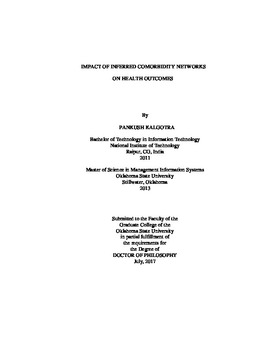| dc.contributor.advisor | Sharda, Ramesh | |
| dc.contributor.author | Kalgotra, Pankush | |
| dc.date.accessioned | 2018-04-23T19:35:31Z | |
| dc.date.available | 2018-04-23T19:35:31Z | |
| dc.date.issued | 2017-07 | |
| dc.identifier.uri | https://hdl.handle.net/11244/299521 | |
| dc.description.abstract | High dimensionality in Big Data can be modeled using network approach. The traditional networks (e.g. online social network) are explicit and easily observed. However, there are certain networks that are implicit and exist by virtue of some underlying collective behavior. Our focus is on these implicit networks, which can be inferred from the secondary data using statistical modeling. An example of such a network is a comorbidity network. In a comorbidity network, diseases form connections based on their co-occurrences in patients. We use data on the health history of 24.7 million patients recorded in US hospitals (2000-2016) to infer comorbidity networks. Since most statistical models depend upon sample size, it is important to study how sample size affects the structure of an implicit network. We study the impact of sample size on comorbidity networks developed using Pearson's Correlation Coefficient (PCC) and Salton Cosine Index (SCI). We present a comparative analysis and show that a network developed using SCI is robust to sample size as compared to the PCC. | |
| dc.description.abstract | Our first study of comorbidity networks employs descriptive analytics. We investigate how comorbidity networks are different across population groups. We compare networks based on gender, race and insurance types. Our analysis at the comorbidity level presents health disparities across population groups. | |
| dc.description.abstract | These disparities across population groups are considered to study the impact of comorbidity network on patients' hospital length of stay in second study. We develop an explanatory and predictive model to estimate length of stay using features extracted from comorbidity networks and compare with the extant models. We show that our model outperforms the existing models. | |
| dc.description.abstract | Finally, we study how an implicit network can help theorize certain phenomenon related to it. With respect to the comorbidity network, we theorize clique property of a network as trap state. The trap state is hypothesized to be related to mortality risk of a patient. We identify eighteen such cliques in a comorbidity network. | |
| dc.description.abstract | This dissertation contributes to network science, analytics and healthcare literature but the theory, models, algorithms, and processes developed are generalizable to other inferred networks. | |
| dc.format | application/pdf | |
| dc.language | en_US | |
| dc.rights | Copyright is held by the author who has granted the Oklahoma State University Library the non-exclusive right to share this material in its institutional repository. Contact Digital Library Services at lib-dls@okstate.edu or 405-744-9161 for the permission policy on the use, reproduction or distribution of this material. | |
| dc.title | Impact of inferred comorbidity networks on health outcomes | |
| dc.contributor.committeeMember | Delen, Dursun | |
| dc.contributor.committeeMember | Luse, Andy | |
| dc.contributor.committeeMember | Benjamin, Bruce | |
| osu.filename | Kalgotra_okstate_0664D_15330.pdf | |
| osu.accesstype | Open Access | |
| dc.type.genre | Dissertation | |
| dc.type.material | Text | |
| thesis.degree.discipline | Management Science and Information Systems | |
| thesis.degree.grantor | Oklahoma State University | |
